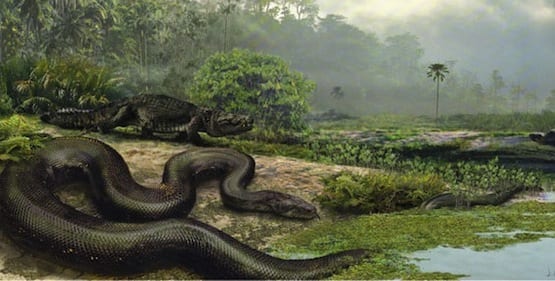The Paleocene/Eocene thermal maximum (PETM) and associated carbon pulse “are often touted as the best geologic analog for the current” manmade rise in CO2 levels, as a new study notes.
The Proceedings of the National Academy of Sciences paper, “Evidence for a rapid release of carbon at the Paleocene-Eocene thermal maximum,” concludes that sediment data indicates the carbon was released in the geologic blink of an eye. As the news release explains, Rutgers geologists Morgan Schaller and James Wright argue that:
… following a doubling in carbon dioxide levels, the surface of the ocean turned acidic over a period of weeks or months and global temperatures rose by 5 degrees centigrade – all in the space of about 13 years. Scientists previously thought this process happened over 10,000 years.
“We’ve shown unequivocally what happens when CO2 increases dramatically — as it is now, and as it did 55 million years ago,” Wright said. “The oceans become acidic and the world warms up dramatically.
Note that if we stay anywhere near our current emissions path, we are headed for a tripling or quadrupling of CO2 concentrations from preindustrial levels.
The nature of the PETM carbon burst has been a puzzle to scientists for a long time, but “Wright and Schaller’s contention that it happened so rapidly is radically different from conventional thinking, and bound to be a source of controversy, Schaller believes.”
Still, any study offering new answers on the PETM merits attention, given the prospect that we might be doing something similar today.
The PETM’s climate would be quite inhospitable to human civilization (see “The Garden of Eden had a 40-foot, 1-ton snake plus 90°F average temperatures“). A 2009 study Naturearticle concluded :
If our Palaeocene estimates are correct, tropical temperatures at the slightly younger (55.8 Myr ago) Palaeocene-Eocene thermal maximum (PETM) could have reached 38-40°C, resulting in widespread equatorial heat-death as recent models and other proxy data have predicted.
A 2006 Nature analysis of deep marine sediments beneath the Arctic found Artic temperatures during the PETM almost beyond imagination-above 23°C (74°F)–temperatures more than 18°F warmer than current climate models had predicted (see “A methane feedback from the past strikes again“). The three dozen authors of the 2006 paper concluded that existing climate models are missing crucial feedbacks that can significantly amplify polar warming.
Significantly, the editor of this new study is none other than the “dean of climate scientists,” Wallace Broecker who popularized the term “global warming.”
Two decades ago, Broecker said, “The climate system is an angry beast, and we are poking at it with sticks.” He stood by that warning in a 2012 interview:
“We’re in for big trouble,” he says matter-of-factly. “There’s been a “true disruption of the basic climate of the planet.”
“My point [with the ‘angry beast’ metaphor] was that by adding large amounts of CO2 to the atmosphere, we were poking our climate system without being sure how it would respond,” he says.
At the rate we are spewing carbon pollution into the atmosphere, one might even say we are punching the climate beast in the nose. Paleoclimate studies, including this new one, suggests that is a very, very bad move.
Source: Climate Progress. Reproduced with permission.










